“Small is beautiful.” This maxim could well apply to Condita with its lack of reception and bar, two in the kitchen, three at front of house, six tables, only two dining options, and a wine list of 20 bottles.

The exterior and location are distinctly low profile: the unremarkable white frontage bearing the name Condita, with blinds obscuring the view from outside, gives little indication this is a restaurant, except for a small notice in the window. Its Salisbury Place address in the Newington district, south of Edinburgh’s Old and New Town, lacks the advantage of a central location or the gastronomic reputation of Leith or Stockbridge.
These limitations are seen as virtues by owner Mark Slaney who opened Condita in November 2018. Certainly, a reception and bar are impracticable given the small size of the room. Two tasting menus make economic sense, minimising food waste. The need to book in advance reinforces this. A short, mainly organic and biodynamic wine list from artisan producers, also reflects the owner’s experience in his parents’ restaurant and as a commercial wine buyer. Six tables facilitate a high staff to guest ratio, giving well-focused personal service and enables the kitchen to function at optimum level. The understated exterior belies the eclectic décor and gastronomic delights inside, whilst the location in an area bereft of fine dining establishments, offers a much needed neighbourhood restaurant of quality. Indeed, with detailed records kept of diners – an advantage of a small restaurant – repeat custom is already evident, including one couple visiting three times in the three months since opening.
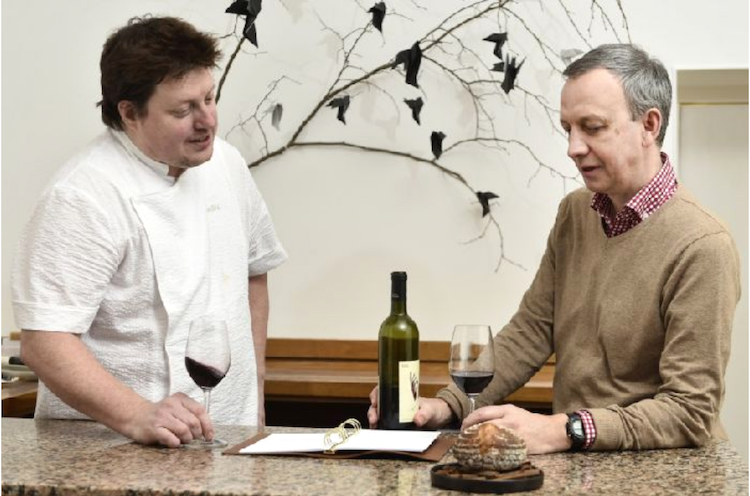
Not that Condita only aims at a local clientele. By engaging Conor Toomey, a chef with a highly distinguished pedigree, it will inevitably attract discerning foodies from further afield. Conor built his reputation as Michael Wignall’s sous chef at the Latymer restaurant at Pennyhill Park in Surrey, which held two Michelin stars, and as head chef at Storrs Hall hotel in Windermere, Cumbria and Amberley Castle in Sussex. Most recently, he led the kitchens at the Michelin starred restaurant at the Isle of Eriska hotel in Oban.
His current position, far removed from those large, corporate establishments, allows him greater freedom to develop his repertoire in line with Mark’s strategy of championing artisan producers and keeping the operation small. Although it is still evolving, Conor’s cooking, based on classical roots but using contemporary techniques, has already reached stellar levels. Highly technical and complex, it employs organic seasonal produce, including fruit and vegetables from a Victorian kitchen garden in the Borders. As Conor says, “It’s all about the ingredients.” Dishes involve harmonious tastes, textures, temperatures and colours, with care taken to avoid over elaboration. Invention, moderated by a clear understanding of how to maximise natural flavours, are much in evidence. Precise timing, with judicious seasoning and saucing, showcase seafood, meat and game at their best, reflecting great respect for the raw material. Attention to even the tiniest detail is astonishing. Beautiful presentation, on a variety of porcelain, slate and stone, is clean and precise without being too contrived.
An element of fun is also evident. The only clue to the eight or five course surprise tasting menu is a single strip of card with hand drawn images of an ingredient for each course. These may comprise the main or a minor component – the diner is left guessing. Added to the mystery is the addition of “snacks” which may arrive between courses and be larger than a course itself!
Prices – £80 for eight courses, £50 for five – are realistic, given the quality of the ingredients and expertise in cooking. They also compare favourably with London restaurants of a similar standard.
A visit on a weekday evening in February finally revealed Condita’s high ceilinged, white walled interior, adorned with cascading hand-painted paper drapes designed by Rachel, Mark’s artist partner. In keeping with the food and drink philosophy, the décor moves with the seasons, the silver and black design reflecting the tone and mood of winter. Well-spaced polished wooden tables, which usually seat two or four but can be extended for six, are arranged in lower and raised areas with spotlighting and candles giving discreet lighting.
Initially, from a choice of three autumnal beverages, we chose a non-alcoholic pear juice. We declined a wine flight with each course, opting instead for just three tasting glasses.
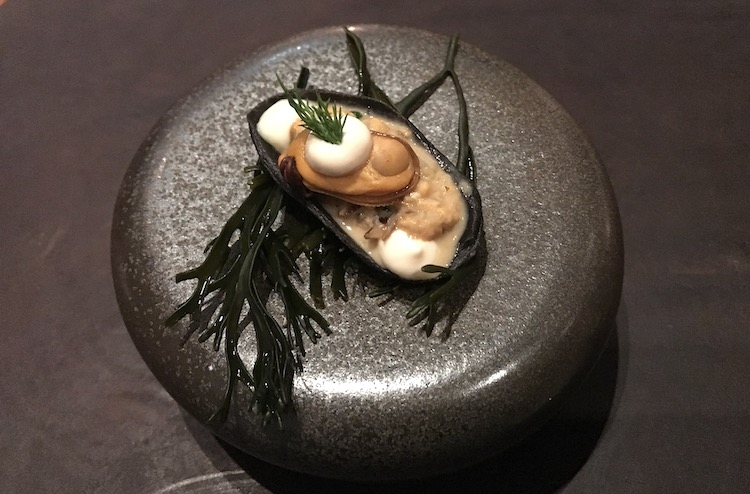
A playful first course featured a Shetland mussel poached in seaweed, resting on cod roe mousse, encased in a delicate “shell” of thin potato. This was a delightful composition of fresh tastes and contrasting textures.
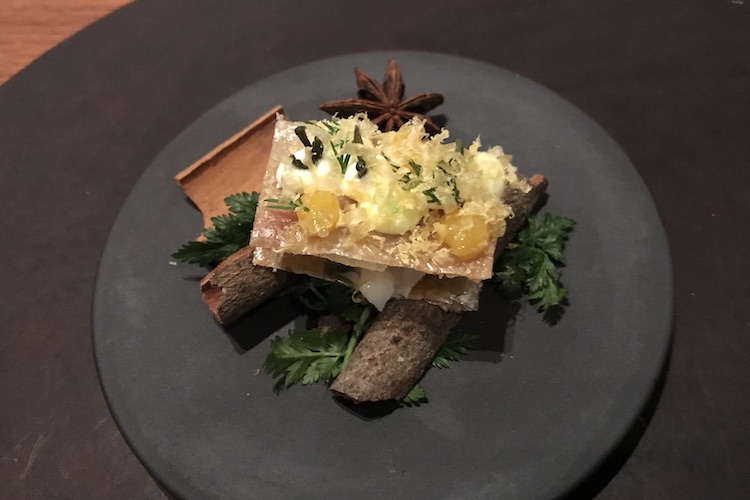
Similarly inventive was the second course of poached haddock, where the mildly sweet flakes of soft white flesh were sandwiched between crisp sheets of chicken skin. Smoked creme fraiche and egg yolk puree added richness, whilst pickled seaweed gave the required degree of acidity. The presentation of this dish, on grey slate garnished with tree bark and leaves, was stunning.
Next came two “snacks.”

Slow cooked ox tongue and tail (above left), meltingly tender morsels of deliciousness, showed how excellent use could be made of humble, neglected parts of the animal. Enveloped in a potato foam of ethereal lightness, the effect was
A glazed chicken wing (above right) cooked on a Japanese barbecue had a gentle smokiness which complimented the richness of the smoked eel hidden inside. This marriage of modest and extravagant ingredients worked particularly well.
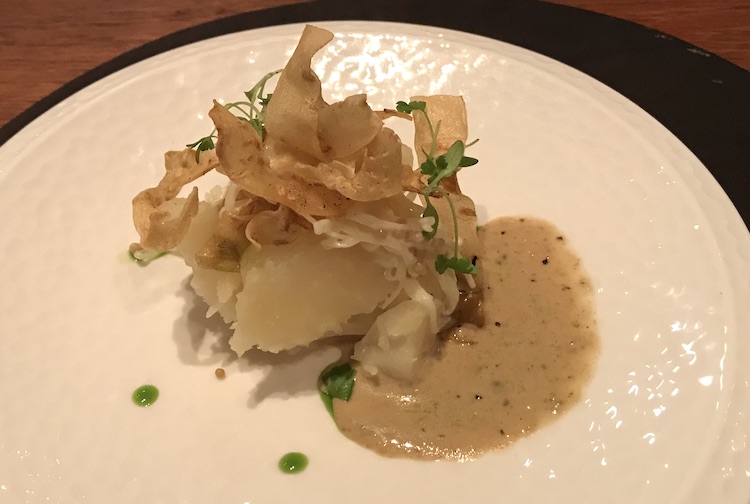
The vegetarian course saw different preparations of celeriac: salt baked and puree, both of which accentuated its sweetness; in a lively, crunchy remoulade; and as delicate crisps. This well-conceived and deftly executed dish demonstrated the versatility of the ugly looking vegetable.
At this stage, and presumably to stop diners gorging themselves ahead on a multi course menu, we were presented with a warm sour dough loaf baked daily by sous chef Spyros. With a crisp crust and firm, mildly lactic crumb, it was a model of its kind.
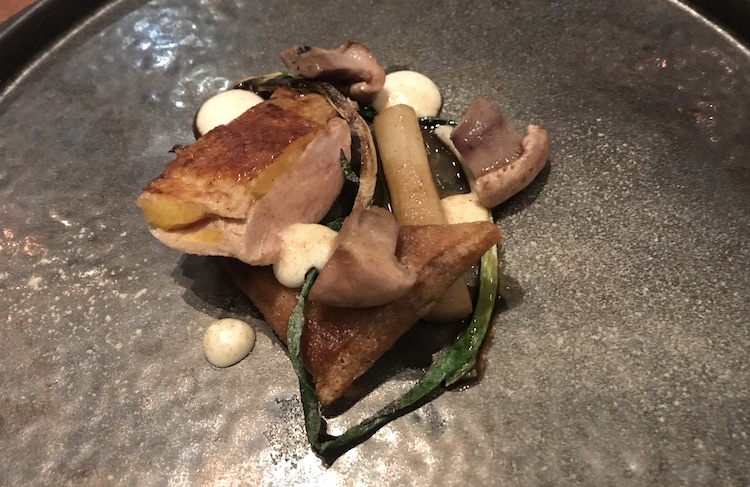
Expecting another vegetarian course, this time showcasing salsify, we were surprised and delighted to be served pheasant. A notoriously difficult bird to master, it was cooked to perfection with moist, crisp skinned breast and a flavoursome pastilla of its leg meat and offal. Salsify, with its creamy white flesh, added a crunchy texture and a taste similar to oyster. The dish was bought together by a light, well balanced thyme and bay jus, which complimented the gentle gaminess of the pheasant.
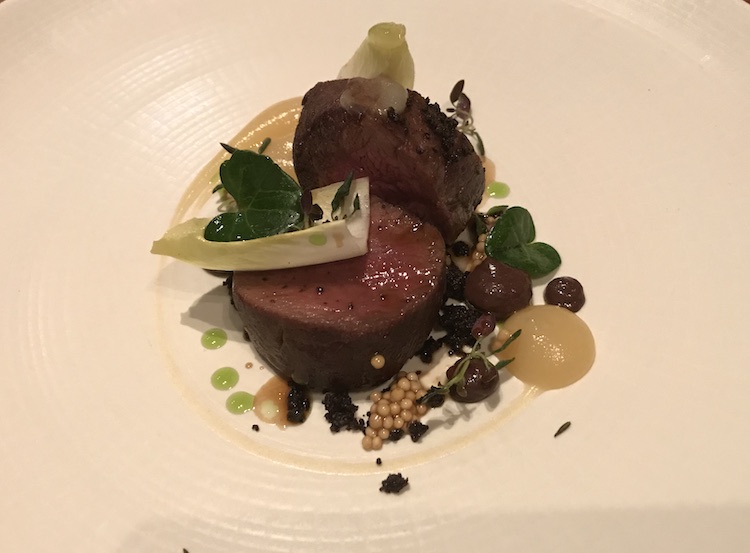
Misled again by the “menu” into expecting celery as a main component, we were spoilt with a second game course! The loin of venison was accurately timed to a blushing medium rare, maximising its deep flavour and smooth, firm texture. A disc of black pudding provided a softer, earthy element that worked well with the venison. Golden beets and apple puree gave sweetness and acidity to balance the richness, scurvy grass added a peppery note, and celery offered a crunchy freshness. Finished with a light jus, this inventive dish was a tour de force of game cookery.
The cheese course of brie, fresh and pickled pear, pear gel, hazelnuts and wafer thin flatbread, showed yet another imaginative approach to simple, seasonal ingredients.
Desserts, often the anti-climax of tasting menus, did not disappoint, being equally if not more accomplished than the savoury courses.

Parsnip in a dessert has been tried elsewhere, but rarely as successful as here, where the parfait and puree were of exemplary consistency and smoothness.
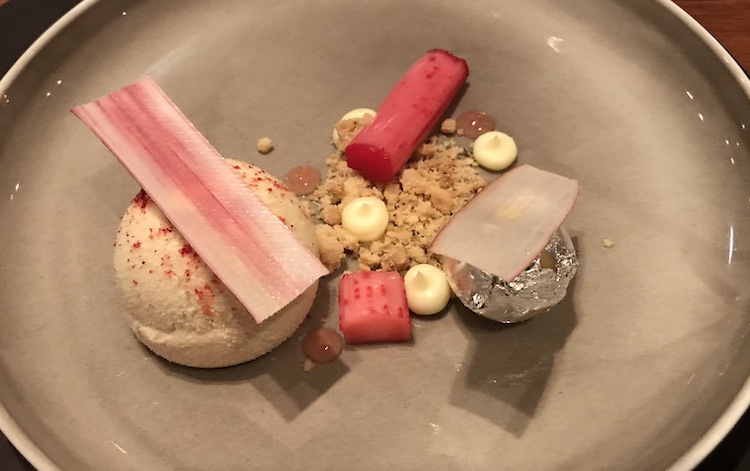
Even better was a composite dessert featuring forced rhubarb with white chocolate, almond custard in edible silver, white chocolate panna cotta, and rosemary crumble. Although unapologetically rich, the herbal and sharp elements from the rosemary and rhubarb ensured it was not too sweet.
Black coffee with home-made Garibaldi biscuits and beetroot and raspberry teacakes completed a memorable meal. The gastronomic experience was enhanced by welcoming, knowledgeable and unobtrusive service involving the whole team: Rachel conducted the meet and greet and served the pre-prandial drinks; Marisol, our waitress, served some of the courses, assisted by sous chef Spyros and Conor himself; and Mark took our order and presented the wines – a floral and honeyed Fiano, a rich and spicy Le Mani, a full bodied red Pignatello and a sweet Jurancon – with a succinct description of their provenance and characteristics.

Condita comes from the Latin to “set up”. The evidence after just three months opening in the low season for restaurants is most encouraging, well on the way to meeting Mark’s vision of “making people happy” with an intimate dining experience of fine food and wine. Overall, the team have now established a restaurant of which they can be justifiably proud. Fine Dining Guide wishes Condita well and hopes to return to sample a different seasonal menu. We look forward in eager anticipation to its inclusion in the respected national restaurant guides.



